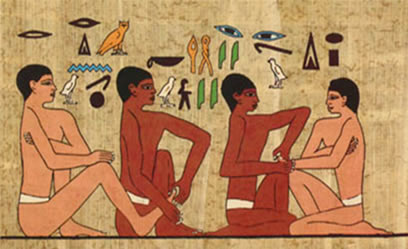
What Are the Acupuncture Points?
The English translation of ‘acupuncture points’ is not very accurate. Acupuncture is one of the many healing methods used in traditional Chinese Medicine. It inserts fine needles into the sensitive points on the body to stimulate Jingluos (meridians) to cure diseases. These sensitive points are called ‘Shuxue’ or ‘Xuewei’ in Chinese Medicine, meaning ‘the transmitting points’. However, this name has been so widely used, there is no point to change it now for our discussion.
Acupuncture points are the responsive points or sensitive points on the meridians and other parts of the body. They are the special locations where energy is transmitted between the inner structures and the surface of the body. These spots can reflect disease or unhealthy conditions by giving forth painful sensations when touched or pressed. These points are (but not limited to) where the therapists apply treatments. When the body is deficient of positive energy, negative or harmful energy will be able to invade the body through these spots, causing illness. Stimulating the related points can boost and mobilize the positive energy, balance Yin/Yang energy and cure the disease. There are three types of points:
1. 14-main-meridian points
2. Extraordinary points
3.’Yes’ points.
The 14-main-meridian points are the spots on the 12 main meridians plus the spots on the governor and conception vessels. Each spot has a unique name and a fixed location. They are the main acupuncture points. The extraordinary points are the points that have names and fixed locations. These locations are not on a particular meridian. ‘Yes’ points are also called pain points, but they don’t have names or fixed locations. They are the sensitive points related to the diseases. The ‘yes ‘name came from a story. When treating a patient, the doctor pressed a spot unintentionally, and the patient uttered ‘oh yes’.
There are approximately 360 acupuncture points in total on the human body. With so many tiny points to remember, one can easily be intimidated. As a matter of fact, for self -healing and caring purposes, we don’t have to memorize all these points. We only need to remember roughly 20 most used and effective points. If you need to use more points, just look for them using the meridian and acupuncture point charts. Each point has a unique and meaningful name, which gives some key information about this particular point, such as main function, usage, location, or other. In English, the English spelling of the Chinese names are directly used. For people who don’t understand Chinese, it is hard to comprehend the significance of each name and, therefore hard to remember all the foreign sounding names.The format of the international symbols for acupuncture points is fairly easy. Since most of the points belong to one specific meridian (Jing), it only makes sense that their symbols are associated with those meridians. You can take two abbreviation letters of that meridian’s name and number all the points along the way, from the starting point to the end point. For example: the name of the Xue-hai point means ‘the sea of blood’ in Chinese and can be used for blood-related issues. Its English symbol is SP10, because it belongs to the spleen meridian and is the 10thpoint from the start.
How to Find an Acupuncture Point?
When considering an acupuncture point as a tiny point, it might be really difficult to find it. However, if you think of it as a small precise area, it becomes quite easy. To locate a subject on a 2D plane, you need 2 coordinates. To locate an sensitive point, we use a reference point and a distance. The reference point is a known location on the body, such as ‘the tip of the nose’, ‘the highest point of the ankle bone’ etc. The distance is measured by your own hand. The unit is ‘cun’. The width of your thumb at the mid joint is one ‘cun’, the width of middle three fingers at the mid joints is two ‘cun’, the width of the four fingers (without the thumb) at mid joints is three ‘cun’. How do you know if you have found the right point? When you press on it, if you feel kind of sore and sense a little pain (acute pain means you are not well somewhere), then you are on the right spot. Every main meridian has a primary point. That is the point where the primary energy of this meridian originates. Stimulating this point is one of the most effective ways to boost the positive energy found in this meridian.

Source by Wendy Q Wang
 Vitamin Agent The Health & Naturalistic Source
Vitamin Agent The Health & Naturalistic Source



